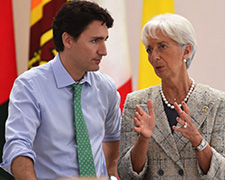The International Monetary Fund’s Influence Over the Canadian Economy
Although I am an avid reader of business books, I try to inject a good spy novel after every two industry related readings. The book I am currently reading, The Death of Money by James Rickards, is an fascinating story about the international monetary system and the ineffectiveness of Central Banks around the world.
At first I categorized this book as pure conspiracy theory. Not the kind of conspiracy that tells of a secret plot by a covert group or organization, but one more in line with the idea that many important economic events and trends are the products of actions largely unknown to the general public.
There is too much reality in The Death of Money to dismiss its account of international monetary events and global politics. When reading The Death of Money I am drawn to past articles in the Economist I have read and to news reports I have seen over the last few years. I ask myself, “Can it be true?”
Then… just this morning while reading a tweet from @don_pittis (Don Pittis), senior producer at CBC’s business unit, I see in his article that Mr. Pittis has referred to the meddling in Canada’s business affairs of Christine Lagarde, Managing Director of the International Monetary Fund (IMF).
The IMF is actually the central bank of the world, despite the fact that the phrase “central bank” does not appear in its name. As you may or may not know, the IMF now has an expanded mandate, including influencing macroeconomic and financial sector issues that bear on global stability.
With this new mandate in mind, during her September 12th visit to Canada Christine Lagarde met with Prime Minister Trudeau, Finance Minister Bill Morneau and other cabinet ministers to discuss the idea of managing overheated sectors within the economy, such as Canada’s housing sector, by creating targeted laws aimed directly at the specific hot zone.
In the case of the mortgage stress tests, the target is first time buyers who may be in danger of borrowing more than they can afford. In the case of foreign buyers, take away the tax incentive.

The dampening of these overheated sectors allows the Bank of Canada to keep interest rates low for all other sectors of the economy in the hopes that Canadians and the Canadian business community borrow money, spend that money and, by doing so, boost the Canadian economy.
Well… we are about to see if this strategy works because the Canadian Government took Ms. Lagarde’s advice and through the Canadian Housing and Mortgages Corporation (CMHC) has made dramatic changes to the insurance coverage for mortgages across the country.
The changes are intense. Here is a summary of only the major change items.
- All insured mortgages must qualify utilizing a weighted average of 5-year bank posted rate
- All insured mortgages must qualify under a 25 year amortization
- Rental properties are no longer eligible for insurance
- Minimum 600 beacon score for insurance
- Mortgages under bulk insurance must qualify under above changes
- Refinance mortgages are no longer eligible for bulk insurance
These changes, now an integral part of the Canadian mortgage industry, have a dramatic impact on mortgage activities for smaller financial institutions.
Christine Lagarde’s short two day visit to Canada does not stop there but continues to have repercussions, as effective November 1st Canada’s banking regulator (OSFI) will increase regulatory capital requirements with respect to mortgages. New capital requirements will force large banks to put aside more capital for mortgages in potentially overvalued cities.
Higher capital requirements for large banks means eventual higher capital requirements for all financial institutions, including credit unions.
The Impact of New Mortgage Rules
Many financial institutions, again including credit unions, have been active in the securitization marketplace. Securitization allowed smaller financial institutions to participate in the “low rate” mortgage market as securitization funding lowered cost of funds by up to 70 basis points, as compared to the marginal customer/member deposit interest rate.
The new changes prescribed for mortgage insurance qualification is expected to dramatically lower the volume of borrowers who are eligible for insurance (transactional or bulk), thus potentially barring smaller financial institutions from now participating in securitization due to required minimum volume levels.
The inability to secure low cost funding through securitization, or as much low cost funding as previously attained, may lead to higher mortgage rates as FIs will be more dependent on over the counter customer/member deposits.
Although only seven banks are impacted by higher capital requirement (RBC, TD, Scotiabank, BMO, CIBC, HSBC and National Bank), the regulations will eventually impact all financial institutions as well as increase mortgage rates.
The fallout will likely be…
- Banks will have a competitive advantage, as they generally have a lower cost of funds allowing them to price their mortgages lower
- Overall mortgage market activity will decline, impacting market values
- Low interest rate mortgages will be available only to individuals with large capacity for debt
- Rental unit occupancy will likely increase as more borrowers are forced to delay home purchases while accumulating a larger down payment
- Since banks internally price mortgages at the same rate across the country, a person in a lower-risk housing market could effectively be subsidizing the rates for someone in a higher-risk market
Strategies to overcome the impact new rules associated with the Canadian housing insurance industry will have on future mortgage business are:
- For those financial institutions expecting to lose securitization volume, the focus should be on increasing sources of low cost deposits.
- If mortgage volumes are expected to decline dramatically, a focus on higher yielding, higher risk mortgages may be needed.
- Front line lending staff must have a long-term focus to help borrowers better qualify for mortgages.
- Develop a high quality laddered investment strategy to ensure excess liquidity does not sit idle.
In the End
Federal Reserve Bank in the USA raised interest rates last December and there is now a 70% probability that they will raise interest rates again this December. If the Bank of Canada does not follow suit and raise interest rates in this country, the Canadian dollar will weaken further. A weaker dollar will mean higher cost imports such as food, clo thes and automobiles leading eventually to inflation. With inflation comes higher interest rates.
thes and automobiles leading eventually to inflation. With inflation comes higher interest rates.
Yet Canada’s economy has not shown signs that it is strong enough to withstand higher interest rates. CTV recently ran a story stating that 48% of Canadians would be in the red if they lost just one paycheque. Add to this the October 6, 2015 report in the Globe & Mail indicating that nearly one in six Canadians could not handle a $500 increase in mortgage payment and the danger associated with rising interest rates becomes evident.
The targeted laws may not be wanted and may not be loved but perhaps they might just be the medicine needed in these times. In the book The Death of Money targeted laws are reportedly now part of the International Monetary Fund’s new arsenal in their attempt to avoid economic excesses. In the world of conspiracy theories, the alternative is financial warfare, deflation, hyperinflation, market collapse and chaos.


